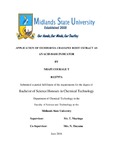Please use this identifier to cite or link to this item:
https://cris.library.msu.ac.zw//handle/11408/2281| Title: | Application of eichhornia crassipes root extract as An acid-base indicator. | Authors: | Nhapi, Courage T. | Keywords: | Chemical technology | Issue Date: | Jun-2016 | Publisher: | Midlands State University | Abstract: | Synthetic acid-base indicators used in titrimetric analysis are highly toxic and harmful to human beings and aquatic organisms. Due to the presence of anthocyanins, some plant extracts have been proved to exhibit solvatochromism properties that can be exploited for use as acid-base indicators in titrimetric analysis. In this research Eichhornia crassipes (E. crassipes) root extract was applied as an acid-base indicator in titrimetric analysis in comparison to standard synthetic acid-base indicators. Solvents of different polarities were used to optimise pigment extraction. E. crassipes root extracts were characterised with HPLC, FTIR and GC-MS and the best extracting solvent was determined. The root extract was tested for the presence of flavonoids and anthocyanins. The root extract was applied in titrimetric analysis for four neutralisation titrations- strong acid against strong base, strong acid against weak base, weak acid against strong base and weak acid against weak base. The best extracting solvent was found to be 0.1 % HCl (v/v) in ethanol by considering the peak areas of the components present in HPLC chromatograms. The root extract tested positive for the presence of flavonoids and anthocyanins. Functional groups that were found to be present were associated with carbohydrates, flavylium ion, phenols and anthocyanins. Cyanidin and perlagonidin derived anthocyanins were predicted to be present due to the presence of selected molecular ions of m/z 287 and 449, and 579 respectively. One way ANOVA showed that there was no significant difference between the mean titre volumes for titration of HCl- NaOH and CH3COOH- NH4OH. The end-points obtained from four neutralisation titrations using E. crassipes root extract were comparable to those obtained using methyl red, phenolphthalein and bromothymol blue. Based on the results in the research, E. crassipes root extract proved to be an effective substitute of phenolphthalein and bromothymol blue for strong acid-strong base and weak acid-weak base titrations respectively, hence it is recommended. | URI: | http://hdl.handle.net/11408/2281 |
| Appears in Collections: | Bsc Chemical Technology Honours Degree |
Show full item record
Page view(s)
138
checked on Apr 26, 2025
Download(s)
148
checked on Apr 26, 2025
Google ScholarTM
Check
Items in MSUIR are protected by copyright, with all rights reserved, unless otherwise indicated.




